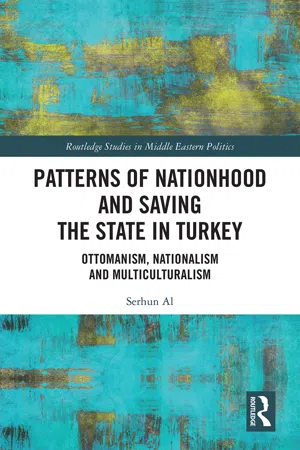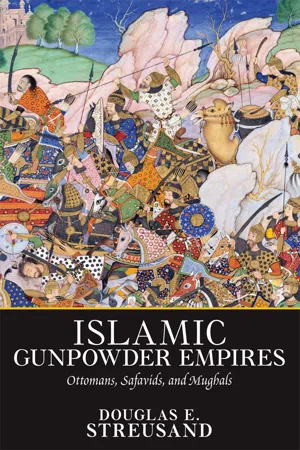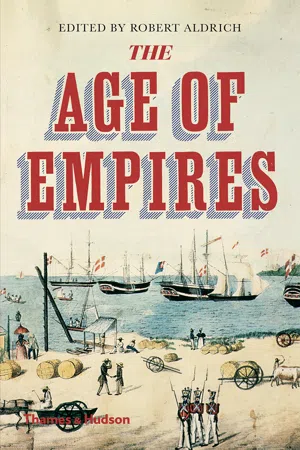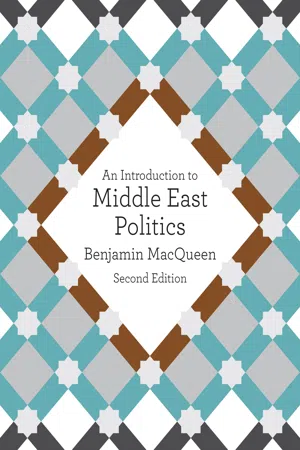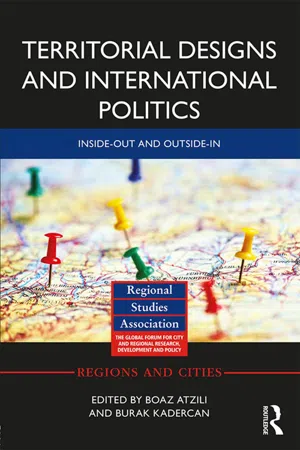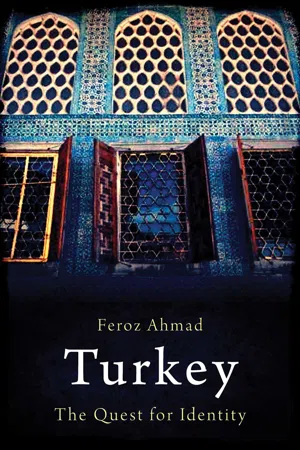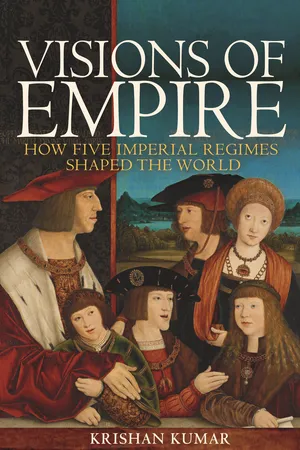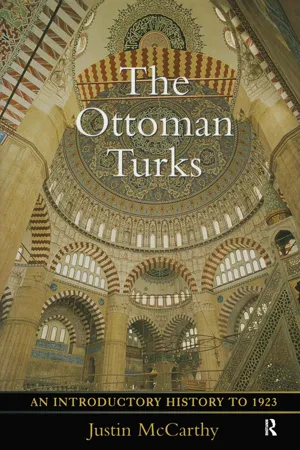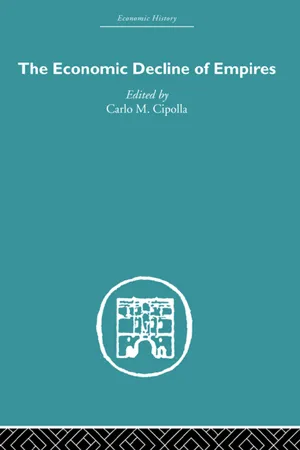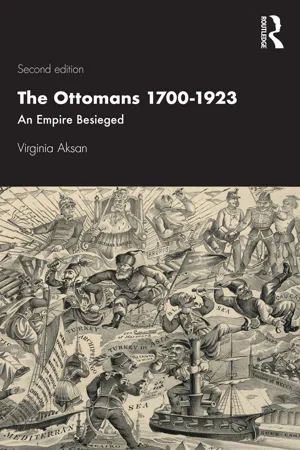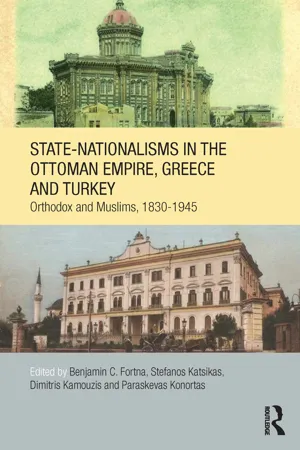History
Ottoman Empire
The Ottoman Empire was a powerful and long-lasting empire that existed from the 14th to the early 20th century, centered around modern-day Turkey. It was known for its expansionist policies, diverse cultural influences, and significant impact on the development of trade, art, and architecture in the regions it controlled. The empire eventually declined and was dissolved after World War I.
Written by Perlego with AI-assistance
Related key terms
12 Key excerpts on "Ottoman Empire"
- eBook - ePub
Patterns of Nationhood and Saving the State in Turkey
Ottomanism, Nationalism and Multiculturalism
- Serhun Al(Author)
- 2019(Publication Date)
- Routledge(Publisher)
As the empires stayed away from top-down social engineering projects of forming one national community and uniformity of rule, the possibility of managing diverse populations through conquest and expansion became the engine of imperial survival for centuries until the idea of nationalism and popular sovereignty was born on the European continent. Overall:Unlike nation-states, empires were or learned to be less committed to constructing an encompassing collective or to making political relations uniform. Moreover, empires did not have constitutions to regularize rights until they moved into a mixed political mode between empire and nation-state. It was the diversity of peoples, communities, and territories, as well as the diversity of rule, that made empires.7Accordingly, the story of the Ottoman imperial system was not unique despite its distinct sociocultural and religious amalgamation that formed the Ottoman way of ruling over and managing diversity. In this chapter, I first introduce a general depiction of the political and sociocultural foundations of the Ottoman imperial system. Then, I explain the historical context of the state of the late Ottoman imperial structure that was subject to a comprehensive reform project in the nineteenth century. Finally, I briefly narrate the domestic and international processes within which the transition to the foundation of the Turkish Republic took place in the first quarter of the twentieth century. The goal of this chapter is to briefly present the historical context of the broader political and sociocultural trends within which the cases under study were incarnated. By doing this, the study of specific cases in the further chapters can be historically situated in the broader sense.The philosophical foundation of the Ottoman Empire
Founded in 1299 near western Anatolia by a tribal family under the leadership of Osman Bey,8 the House of Osman as the Ottoman state managed to survive, expand, and rule over transcontinental regions of the Balkans, Middle East, and North Africa for more than six centuries until its demise in 1923. The empire functioned as the vanguard of Islam that “the political legitimacy of the Ottoman state was based on its ability to defend the ummah and maintain its welfare within the Abode of Islam.”9 The concept of justice was at the center of the imperial foundation of the Ottoman state that emphasized law and order rather than equality. Status quo—in which each community was expected to remain in their own borders and not trespass on the rights of others—“entailed a basically conservative political outlook, in which any change in the social order had negative connotations.”10 - eBook - ePub
Islamic Gunpowder Empires
Ottomans, Safavids, and Mughals
- Douglas E. Streusand(Author)
- 2018(Publication Date)
- Routledge(Publisher)
Chapter 3 The Ottoman EmpireT he Ottoman Empire’s long history, large size, and pivotal location offer multiple angles of approach to historians. Western historians have commonly seen the Ottomans as an alien threat, part of the Turkic third wave of Islamic aggression against Christendom. From the perspective of Islamic history, it was part of the second political and cultural flowering of the Islamic world. From a geographic perspective, it appears as a reassertion of the imperial pattern of the Eastern Roman (Byzantine) Empire. Fernand Braudel considers the Ottomans part of a unified and coherent Mediterranean region. Arab historians, like the Europeans, regard the Ottomans as intruding aliens. Each of these views of the Ottomans has an element of truth. The Ottomans carried the traditions and conflicts of the post-Abbasid Turko-Irano-Islamic political matrix into the fertile ground—literally and figuratively—of western Anatolia and the Balkans. Its geographic setting, the specific circumstances of its development, the quality of its leadership, its institutional development, and its military organization permitted the Ottoman polity to overcome the chronic weaknesses of post-Abbasid political formations and establish an enduring and extensive empire. The Ottomans integrated themselves into the political and economic environments of Europe and the Mediterranean.For more than two generations, most historians have accepted the view of Paul Wittek that the Ottoman state, from beginning to end, had one primary reason for being: ghaza , which Wittek does not distinguish from jihad. Heath Lowry has recently demolished the Wittek thesis and discredited much of the scholarship behind it. As explained in chapter 2 , frontier ghaza did not coincide with the legal concept of jihad. Even after a more formal and legal conception of ghaza - eBook - ePub
- Robert Aldrich(Author)
- 2020(Publication Date)
- Thames and Hudson Ltd(Publisher)
hajj (pilgrimage), he was custodian of the holy cities of Mecca and Medina, and he held the ultimate temporal authority for Muslims as far away as Senegal and Sumatra. The empire’s second career started from the mid-eighteenth century, when it gradually succumbed to European powers that had found the means to exercise global political and economic domination. By that stage, the Ottomans had acquired the disreputable image of a ramshackle anachronism: the empire was now the principal site for Western fantasies of ‘Oriental’ decadence. To survive, the empire struggled to renew itself, and but for the intervention of the First World War it might well have survived in a workable, albeit truncated, form.Founded in 1300 and dissolved in 1922, the Ottoman Empire was one of the most durable in world history. How does one account for its durability? How did it assert such firm control over the Balkans and the Middle East, perhaps the most militarily contested zone in world history?Pastoral background
Some answers can be found among the semi-arid steppes of Central Asia, the ancestral homeland of the Ottoman Turks. As with the Huns and Mongols, the Turks were pastoral nomads who formed tribal confederations and created vast (albeit short-lived) empires from the sixth century CE . Around the eleventh century, Turks migrated south and formed a series of powerful states from the Mediterranean through to India, including the Delhi Sultanates (1206–1526) and the great Mughal empire (1526–1707).That nomads should be able to produce such formidable military states had much to do with the exceptionally unstable nature of the pastoral economy of the steppes. As the Chinese historian Sima Qian noted, ‘It is the custom to herd their flocks in times of peace and make their living by hunting, but in periods of crisis they take up arms and go off on plundering and marauding expeditions.’2 - eBook - ePub
- Benjamin MacQueen(Author)
- 2017(Publication Date)
- SAGE Publications Ltd(Publisher)
The pre-colonial, imperial history of the Middle East is often discounted as simply a long trajectory of decline that left the Middle East open for colonial exploitation. In contrast, this period is presented here as leaving profound legacies for the political, social and economic landscape of the region, legacies that intertwined with and often outlasted patterns of colonial rule in the modern Middle East. In particular, the slow decline of the Ottoman Empire and its efforts to resist territorial losses, economic decline, cultural malaise and the emergence of new identities and allegiances had immense impacts on the region. Through a brief overview of the people, identities and religions of the region this chapter will explore the patterns of Ottoman rule and its legacies. Understanding the legacies of the imperial era in the Middle East allows a greater comprehension of the impacts of colonialism and the formation of the state system in the region.The Middle East in the Imperial Era
The Ottoman Empire was a multi-ethnic and multi-confessional realm. It reached its peak between the 17th and 18th centuries, during which time it developed an elaborate set of policies to manage relations between the many groups it ruled to ensure their political and economic representation, as well as to prevent challenges to its character as a Muslim Empire. This was challenging as the Empire ruled over a domain stretching throughout the Middle East, North Africa and into South-Eastern Europe. This section will outline and discuss the religious and ethnic composition of the Ottoman Empire, with a focus on the Middle East and North African territories under Ottoman rule. It will include a brief discussion of the Middle East’s religious heritage as the birthplace of the three dominant monotheistic faiths of Judaism, Christianity and Islam, the role of religious identity in the late Ottoman period, and the intersection of this with the emerging ideologies of ethnically based national identity.The Middle East’s Religious and Imperial Heritage
The Middle East is the birthplace of the three monotheistic faiths of Judaism, Christianity and Islam. The common theme of monotheism, or belief in one God, along with their shared history in the Middle East, has tied these religious traditions together. They share a number of features outside this central tenet of monotheism, in particular a focus on law, social justice and eschatology (life after death). In addition, religion and religious identity have been key themes in Middle Eastern political life to today. - eBook - ePub
Territorial Designs and International Politics
Inside-out and Outside-in
- Boaz Atzili, Burak Kadercan, Boaz Atzili, Burak Kadercan(Authors)
- 2018(Publication Date)
- Routledge(Publisher)
This spatial categorization suggests that the Ottomans did not think of the global territorial order in binary terms defined as spaces of war versus spaces of Islam, but were cognizant of the grey zones (with many shades of grey, that is) that were not amenable to religion-defined homogeneity. As will also be discussed, this macro-geopolitical perspective suggests that the Ottomans were intentionally trying to create lands of stability in areas where they conquered or were thinking of conquering down the road. This perspective is also compatible with their approach to territory in practice, which was built on a great deal of flexibility and pragmatism.(2) Territorial heterogeneityAs mentioned above, until the nineteenth century, the Ottoman Empire’s territorial design was built on flexible boundaries and a system of heterogeneous management with respect to the space–society–politics nexus. The flexibility and heterogeneity, in so many ways, were a function of the origins of the Ottoman institutions and the make-up of the populations they ruled.While the Ottomans are usually depicted as primarily an Islamic empire, the Ottoman imperial system evolved or ‘was derived’ from numerous sources including the Byzantine Empire as well as Turkic and nomadic traditions, not to mention previous Near Eastern models of administration (Agnelov, Batsaki, & Bazzaz, 2013; Yurdusev, 2004, p. 17). Such diversity in design is not surprising given the temporal and spatial extent of the empire. In the words of Gocek (2013, p. 74), ‘[The Ottoman Empire’s] temporal reign traversed the modern and pre-modern eras, and its geographical land mass covered parts of Eastern Europe, the Balkans, Asia Minor, the Arabian Peninsula, and North Africa.’ The complexity of the Ottoman institutions only increased with further expansion, as the empire ‘became increasingly heterogeneous as it spread over three continents’ (Karpat, 1977a, p. 2).The population over which the Ottomans ruled was also considerably diverse. Even Asia Minor, which is today highly homogenous with respect to religious and ethnic dimensions (thanks to the population transfers of the twentieth century) and usually accepted as the Turkish homeland, was marked by high levels of ethnic, religious, and sectarian differences. Such diversity and the mixed settlement of different social groups made it impractical, or at least very difficult, for the Ottoman state to impose a homogenous administrative and political system within their domain. - eBook - ePub
Turkey
The Quest for Identity
- Feroz Ahmad(Author)
- 2014(Publication Date)
- Oneworld Publications(Publisher)
1
The Ottomans: from Statehood to Empire, 1300–1789
THE EMERGENCE OF THE HOUSE OF OTTOMAN
The Turkic tribes, under the leadership of the Seljuks, established their foothold in Anatolia in 1071, five years after the Norman invasion of England. Alparslan defeated the Byzantine emperor Diogenes at the battle of Manzikert and laid the foundations of the Seljuk Empire, the Seljuks of Rum, with their capital at Konya. Rum was the term used by early Muslims to describe the Byzantines as ‘Romans’ and their empire was called the ‘land of Rum’. Later the term was applied to Asia Minor or Anatolia and, until the present, to the Greeks of Turkey. The Seljuk Empire was a federation of Turkish tribes, each led by its own bey, or leader, who recognized the sovereignty of the Seljuk dynasty. But when the Seljuks were defeated by the Mongols in 1243 and became their tribute-paying vassals, the beys began to break away from the Seljuks and declared independence for their principalities or beyliks.The Ottomans had their origins in a clan that was loyal to the Seljuks, who rewarded their leader, Ertuğrul, with lands near Ankara which were extended further west to the region of Söğüt near modern Eskişehir. Ertuğrul is said to have died in 1288 at the age of 90 and was succeeded by his son Osman, whose name was adopted by his followers who called themselves Osmanli, anglicized to Ottoman. As most vassals seized the opportunity to declare their independence as the Seljuks declined, Osman remained loyal until the death of Sultan Kaikobad II in 1298. Osman then declared his independence, marking the beginnings of the Ottoman state. Osman’s principality abutted the Byzantine empire and he was able to wage religious war, or gaza, against the Christians, enabling him and his successors to become religious warriors (gazis) par excellence and attracting followers from all over Anatolia. This was a great advantage that the Ottomans had over most of the other principalities. Osman Gazi died in 1326 and was succeeded by his son Orhan Gazi (r.1326–59), who captured the strategic city of Bursa in the same year, making it the first capital of the Ottoman state. At this stage the leaders enjoyed the title of gazi - eBook - ePub
Visions of Empire
How Five Imperial Regimes Shaped the World
- Krishan Kumar(Author)
- 2017(Publication Date)
- Princeton University Press(Publisher)
devshirme), the Ottomans were “a cosmopolitan ruling class distinguished by the imprint of Ottoman court culture” (Findley 2005: 230; see also Goffman and Stroop 2004: 141). They included—“like all imperial ruling classes”—“individuals from an astonishing array of different backgrounds—Albanian, French, Venetian, Arab, Jewish and Circassian” (Mazower 2005: 281; cf. Goffman 2002: 51). Even the language of the Ottomans—Ottoman Turkish—was not the Turkish-Persian synthesis of most Central Asian Turks but an amalgam of Turkish, Arabic, and Persian, embellished with Greek, Slavic, and Italian additions—a truly cosmopolitan creation, and one largely inaccessible to the mass of Turkish peasants (Findley 2005: 156; Hanioglu 2008: 34–35). It was by engaging in and identifying with Ottoman culture that one showed oneself a member of the Ottoman elite; hence any educated and cultivated denizen of the empire would think of and call himself an Osmanli. “Only when the last European provinces were almost lost, and the loss of the Arab provinces was well within sight, did political leaders in Istanbul begin to think and to speak of themselves as Turks” (Seton-Watson 1964: 10).“The Ottoman ruling class eventually emerged as a combination of Muslims (some by conversion) who spoke Turkish (though not necessarily as a native tongue) affiliated (some voluntarily and some involuntarily) with the dynastic state under the rule of the House of Osman” (Kafadar 1995: 4). The Ottoman Empire, perhaps more than any other of the European empires, was a dynastic, multinational, empire, ruling over a variety of peoples. As Colin Imber puts it, “the Ottoman Empire was not . . . exclusively Islamic; nor was it exclusively Turkish. Rather, it was a dynastic Empire in which the only loyalty demanded of all its multifarious inhabitants was allegiance to the sultan. . . . It was in the end the person of the sultan and not religious, ethnic or other identities that held the Empire together” (Imber 2002: 3; cf. Rodrigue 1995: 84; Bayly 2004: 220). Ottoman theory stressed that all subjects and lands within the realm belonged to the sultan, and that all rights stemmed from his will. Unlike the European nobility, the Ottoman ruling class enjoyed no hereditary rights. It was a purely functional ruling class, defined not by ethnicity, language, or religion, but by its role in the running of the state (Sugar [1977] 1993: 273). When the Ottomans acquired a territory, they abolished, at least in principle, all local and inherited rights and privileges (though, as we have seen, in the early years they were careful to respect these rights in the case of their Balkan subjects). At the death of the reigning sultan all commissions and rights became invalid and had to be reconfirmed by his successor. Louis XIV famously claimed that “l’état, c’est moi”; but given the strength and customary rights of the French aristocracy, this was a pale reflection of the power of the Ottoman sultan. For the Ottomans, as Halil Inalcik says, “there was real meaning in the common expression, ‘the Sultan was the state itself’” (Inalcik 1954: 113). - eBook - ePub
The Ottoman Turks
An Introductory History to 1923
- Justin Mccarthy(Author)
- 2014(Publication Date)
- Routledge(Publisher)
There was some truth in all these images, and others, of the Ottomans. The sultans indeed were great warriors who caused Christian Europe to tremble, but they were also able administrators who held their conquests for five hundred years through competent rule. Some of the greatest sultans, such as Selim I, were indeed cold and, when statecraft called for it, brutal. Others, such as Selim's father, Bayezit II, were religious and philosophical rulers more interested in internal improvements in the Empire than in conquests. Some officials were indeed corrupt, but were they any more corrupt than the Europeans who criticized them? (Casting the first stone might be difficult for anyone involved today in the granting of contracts for municipal construction projects.) On the positive side, the Ottoman Empire at its height was indeed more of a meritocracy than was any European state of the time, but the son of a Grand Vezir was still considerably more likely to succeed in government than was the son of a peasant. In short, the Ottoman state was complicated, sometimes politically effective, sometimes not, and not always easy to understand.Beginnings
The first government of the Ottomans was indistinguishable from the military. Following the old Turkish tradition of the naming of a leader, the han , the first Ottoman leaders took power because of their prowess as military commanders. Their political advisors were also those whom they put in charge of the troops. In a state that was very close to its nomadic roots, the distinction between minister of state and general was small or nonexistent.As their conquests expanded, the Ottomans came into contact with more settled systems of government – the Byzantine Empire, with its Roman and Greek traditions, and the Islamic governing systems of the Arabs and Persians. Gradually the Ottomans evolved a governing system that was far from their nomadic roots. The ruler became more removed from the people, in the Middle Eastern and Byzantine style, and dependent on a bureaucracy. Court ceremonial more and more resembled Persian ideals; for the sultan and his retainers, silks replaced rougher clothes. But the Ottomans never completely forgot their Turkish nomadic roots. The sultan was always officially described as ‘the Han, son of the Han’, and on parade he and his main advisors could be identified by the horsetails on their standards, the mark of leadership among their Central Asian ancestors. Some Turkish military and leadership practices lasted until the end of the Empire, but the nomadic Turks in Central Asia had no treasury or taxation system fit for a great empire and indeed had few ideas on how to rule over farmers and merchants. For those principles the Turks had to look to the Persians, the Arabs, the Byzantines, and others. - eBook - ePub
- Carlo M. Cipolla, Carlo M. Cipolla(Authors)
- 2013(Publication Date)
- Routledge(Publisher)
This apathy of the Ottoman ruling class is the more striking when contrasted with the continuing vigour of their intellectual life. An example of this may be seen in the group of writers who memorialized on the decline of the Empire, which they saw so clearly but were powerless to stop. We may point also to the brilliant Ottoman school of historiography, which reaches its peak of achievement in the work of Naima (1655–1716); to the Ottoman traditions of courtly and religious poetry, two of the greatest exponents of which, Nedim and Şeyh Galib, lived in the eighteenth century; to the Ottoman schools of architecture, miniature and music. It is not until the end of the eighteenth century and the beginning of the nineteenth that we can speak of a real breakdown in the cultural and intellectual life of Turkey, resulting from the utter exhaustion of the old traditions and the absence of new creative impulses. And even then, behind the battered screen of courtly convention, the simple folk arts and folk poetry of the Turks continued as before.In the late Middle Ages, the Ottoman Empire was the only state in Europe which already possessed the territory, the cohesion, the organization, the manpower and the resources to carry the new apparatus of warfare, the crushing cost of which was outmoding the city states and feudal principalities of medieval Europe, as surely as modern weapons have outmoded the petty sovereignties of Europe in our own day. In part perhaps because of that very primacy, it failed to respond to the challenge which produced the nation-states of sixteenth-century Europe, and the great commercial and technological efflorescence of which they were the scene.Fundamentally, the Ottoman Empire had remained or reverted to a medieval state, with a medieval mentality and a medieval economy – but with the added burden of a bureaucracy and a standing army which no medieval state had ever had to bear. In a world of rapidly modernizing states it had little chance of survival.The stages in the decline of Ottoman power and grandeur are well marked by public, international treaties. The first was the treaty of Sitvatorok, signed with Austria in November 1606. For the first time, this was not a truce dictated in Istanbul to the ‘King of Vienna’, but a treaty negotiated on the frontier and agreed with the ‘Roman Emperor’. The Ottoman Sultan had at last consented to concede the Imperial title to the Habsburg monarch, and to treat with him as an equal. - eBook - ePub
The Ottomans 1700-1923
An Empire Besieged
- Virginia Aksan(Author)
- 2021(Publication Date)
- Routledge(Publisher)
Populations in such loosely governed lands developed their own survival skills that depended on kinship and/or warrior bands and settlements that could make most use of the fluidity and fragility of multiple forms of governance. From the distance of several centuries, it is hard to imagine on the one hand, the intensity of the closeness of isolated communities, and on the other, the fluidity of pastoral nomads or roving rapacious bands. The appearance of an army in full regalia—the empire on parade with the sultan at its head—must have been heard hours before its arrival, and terrifying in its beauty and destructiveness. Süleyman ruled from Istanbul as the shadow of God on Earth, sovereign of three continents, including Mecca and Medina, and as caliph of the Muslim populations of the world, making the Ottomans a global phenomenon. Europeans were terrified, some dazzled, by an empire that welcomed all, renegades and/or aristocrats, by a simple matter of conversion to Islam. Others scorned a system built on slavery and lack of inherited status. The benefits for those who styled themselves Ottomans were enormous. The Ottoman ethos embraced the notion of a family, often referred to as a political household, the largest being that of the sultan himself. His beneficence began with his loyal sons, the Janissaries, and extended to the smallest peasant, his flock (reaya), who had the right of appeal to sultanic justice. The legitimacy of the Ottoman dynasty rested on its adherence to Islamic law, the shar‘ia, justified by the seal of approval of the Ottoman chief religious officer (Şeyhülislam); although, in actuality, sultanic writ and common law had long infused the Ottoman legal system. The problem of imperial aims and religious justification was hardly unique to the Ottoman context - Halil Berktay, Suraiya Faroqhi(Authors)
- 2016(Publication Date)
- Routledge(Publisher)
beyliks as predecessors and quasi-extensions of the Ottoman Empire. While it is of course well-known that the Ottoman principality defeated its competitors in war and eliminated their ruling dynasties, this aspect of fourteenth to early sixteenth-century Anatolian history generally recedes into the background.Turkish historians of the Republican period generally assume the existence of a clear break between the Turkish Republic and the Ottoman Empire. But at the same time they regard the Turkish Republic as a ‘successor state’ to the Empire in a sense that is quite different from the manner in which Yugoslavia, Hungary or Greece are also ‘successor states’. Therefore Ottoman and beylik period history are defined as part of the national history of the Turkish Republic. However, this does not apply to classical Greek, Roman or Byzantine history, even though major sites of these three civilizations are located in Anatolia and Thrace, and historians or archeologists have occasionally suggested that the boundaries of national history be redrawn in order to include these disciplines as well. However, very few Turkish writers on history, often from outside the academic community, have emphasised continuities between the history of antiquity, Byzantium and the Ottoman period.8 For the most part, such continuities, mostly on the level of popular culture, have attracted the interest of journalists and literary figures opposed, in one way or another, to the notion of a Turkish-Islamic synthesis without the slightest leavening of cosmopolitan traits.9 Given the formidable barriers between academic and non-academic intellectuals in present-day Turkey, such currents have had almost no impact upon established Ottoman historiography. Thus the beylik- eBook - ePub
State-Nationalisms in the Ottoman Empire, Greece and Turkey
Orthodox and Muslims, 1830-1945
- Benjamin C. Fortna, Stefanos Katsikas, Dimitris Kamouzis, Paraskevas Konortas, Benjamin C. Fortna, Stefanos Katsikas, Dimitris Kamouzis, Paraskevas Konortas(Authors)
- 2012(Publication Date)
- Routledge(Publisher)
1 The Ottoman Empire and afterFrom a state of “nations” to “nation-states”
Benjamin C. FortnaIntroduction
For the Ottoman Empire in the nineteenth century with its still wide swathes of territory stretching from the Balkans to the Persian Gulf and its seemingly endless procession of confessional, ethnic and linguistic groups, the innovation of states based on national identity represented a mortal threat, as indeed, it did to other imperial structures of similarly diverse composition. None of the major empires, the Romanov, the Hapsburg and the Ottoman, would survive the early decades of the twentieth century. What set the Ottoman case apart from the others was the direct involvement of the Western powers in the process of imperial dismemberment. When even its erstwhile allies began to help themselves to portions of Ottoman territory whose integrity they had recently promised to protect—the French seized Tunisia in 1881 and the British helped themselves to Egypt the following year—it was clear that the external environment was turning increasingly hostile to the empire's existence.On the internal front, itself increasingly complicated by the changing international situation, national identification and organization presented formidable challenges to the Ottoman system of communal relations. The new national impetus not only disturbed the lived reality of late Ottoman existence but also, in ways both subtle and brutal, inevitably affected the way we view the transition from empire to post-empire. In other words, it shaped—and continues to shape—both the history and the historiography of that period.This introduction is intended to offer an overview of the minorities question in the late Ottoman and post-Ottoman context in order to set the stage for the more substantive chapters that appear in the following pages. I begin with a brief discussion of the main subject of this volume, namely the parallel (but far from identical) trajectories of the “Greek minority” in the Ottoman Empire and Turkey, on the one hand, and the “Muslim minority” in Greece on the other. I then reflect briefly on the term “minority” in its Ottoman context, before turning to a cursory attempt to situate the Ottoman state's approach to its varied population. I conclude by highlighting the problematic nature of rigid categories and definitions that hamper our ability to see the fluidity of linguistic, cultural and even religious identities in the imperial context on the eve of the nation-state era.
Learn about this page
Index pages curate the most relevant extracts from our library of academic textbooks. They’ve been created using an in-house natural language model (NLM), each adding context and meaning to key research topics.
